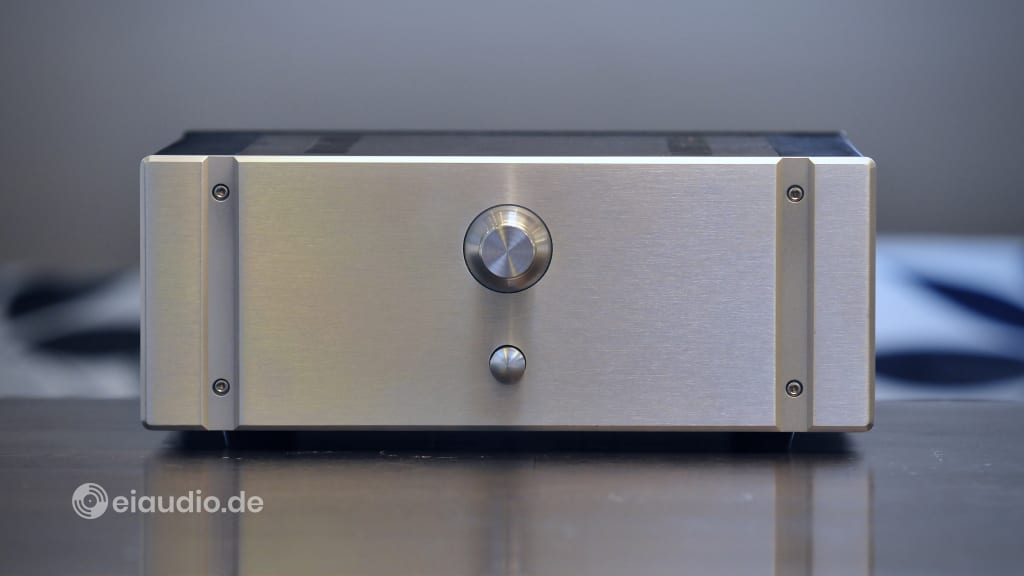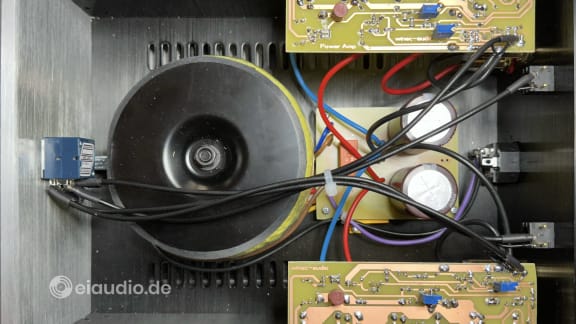Echle LF-3519
Published: 29/12/2022
Manufacturing date: 2022
Author: Karsten Hein
Category: Gear & Review
Tag(s): Power Amplifiers
When building our first signature power amplifier for eiaudio, the developer Winfried Echle and I were looking to fulfil four basic demands: First, to make minimal use of components, basically following the audiophile rule of less-is-more. Second, to assure sufficient back current stamina to power complex loads. Third, to achieve superior agility and musicality. And, finally, to create some visual understatement in the shape of a sleek and modest-sized enclosure.
eiaudio’s first dedicated power amplifier was to be designed on the basis of an earlier project that had involved four Sanken 2SC-3519A bipolar transistors per channel. To improve power handling, it was decided to increase the capacity of the supply by upgrading to a toroidal 500 VA transformer paired with two 10,000 mF capacitors instead of the original 250 VA transformer. We were aiming for the larger transformer to assure more power on demand while the fairly modest capacitors would preserve the amp’s agility.
The four Sanken 2SC3519A transistors per channel were able to handle currents of 15 A at high operating temperatures, although chances of this particular amplifier ever running hot were rather slim, since bias current was only set at 5 watts per channel output into 8 Ohms. To prevent the amplifier from producing the typical popping sound from the magnetisation of the transformer, a resistor-relay combination was put in place behind the power supply. As I later found out, this simple circuity was quite effective during the power-on phase, but it did lead to a mild popping sound about 30 seconds after the amplifier was turned off, most likely from the relay switching off.
The housing for the amplifier was sourced from the Chinese eBay-seller Douk Audio, at a time when imports from China were particularly pricey due to multiple disruptions to world trade that reached from pandemic measures to high petrol prices and border closures for political reasons. All this drove non-EU import prices up and lead to more competitive local offers, e.g., coming from the France-based electronics trader Audioholics. However, in the end, it was the list of specifications and not the more competitive pricing that led to our decision in favour of the Douk Audio amplifier enclosure.
The housing offered plenty of interior space (W) 220mm, (H) 112mm, (D) 300 mm to allow for some distance between the two amplifier boards and the power supply. This would help to reduce the likelihood of audible transformer humming to be heard on the loudspeakers. At 6.5 kg, the cabinet was sturdy enough to help further suppress mechanical vibrations on the HiFi rack. The massive aluminum face plate was of symmetrical design and featured a solid, polished aluminum knob for gain adjustment as well as a machined aluminum power switch. The sides were two massive heat sinks that would offer more than enough cooling under any circumstances.
The power switch felt firm and solid during switching. Paired with the amplifier’s soft-start circuit, it made for a high quality user experience. The same could be said for the aluminum volume control. Input gain could be continuously adjusted between 0 to 1.4 volts via an Alps Blue series attenuator. This, too, gave excellent haptic feedback. The housing needed to be assembled upon arrival which turned out to be an easy task. We used gold-plated cinch/RCA sockets for line input and gold-plated, low-mass binding posts for use with bananas or spades for the output to the speakers. We also decided to keep the small rubber feet that had come with the cabinet and to later place these on additional isolation pads for acoustic decoupling from the rack.
Winfried designed the two circuit boards (one per channel) so that they would house only the most essential amplifier parts, strictly those that were necessary to maintain and amplify the source signal in as pure a fashions as possible. And, sure enough, with the measuring equipment we had available, the amplifier showed a deviation of 0 dB across the relevant frequency spectrum from 20 - 20,000 Hz. Although Winfried had previously built amplifiers with very high damping factors, I suggested that musicality was more important to me than absolute control. Hence, the LF-3519 was designed with a relatively low feedback in mind. Signal damping was rated at 600:1, which is still low enough not to be overly analytical.
When I first heard the LF-3519 perform, I was immediately drawn into the music. Winfried had connected his revised Tang-Band W8-2314 with open-baffle dipole, and I could feel an intriguing mixture of strong command in the bass notes and softly breathing vocals. There was a pleasant fullness and warmth, a nice sense of tonal colour that I could enjoy. On that day I could not wait to take the amp home with me to test on our electrostatic system. One requirement had been for the amp to perform well on difficult loads and to have the power to drive our Martin Logan electrostatic speakers.
Upon first connecting the LF-3519 on our system at home, I heard the hissing of our Dynaco PAS-4 tube preamplifier. I then dialled the input attenuator back, until the system was near silence when standing right next to the speakers. With the LF-3519 set in this position, I saw that our regular listening volume was achieved when setting the PAS-4 volume dial between nine and twelve o’clock which was considered the ideal operating space for any attenuator. When I started listening to my familiar Jazz and Vocal Jazz albums on vinyl and CD, I heard a new firmness and agility in the music. The LF-3519 drove the Mylar diaphragms far more effortlessly into the higher frequencies than any of our previous amplifiers. Bass was quick and punchy with a swift decay. Vocals were a luring combination of rawness and softness.
When required by the music material, the LF-3519 would have the Martin Logans deliver bass runs that were astounding each time, both in volume and extension. The point being that there was usually no trace of this quality until the bass started to kick in. Although I am not that interested in bass performance, it was on these occasions that I turned to look at my wife just to confirm that she, too, had heard what I had just heard. While some of these qualities were already present a few hours after construction, proper tonality matured over the next few days and weeks.
One tendency we did notice was the amps readiness to pick up and amplify random noises from our household. And so it happened that just two days after our absolute listening bliss, the music began to sound harsh and constrained. At first I thought that something might have broken on the LF-3519 itself, or that this was perhaps an unpleasantness in character I had missed in my earlier listening. As it turned out, our LED-Christmas light transformer was emitting obnoxious waves into the grid. We eliminated the noise source, but we soon noticed other issues, for instance when our children placed their nightlights on the charger. The result usually was an unpleasant hissing and brightness resulting in listening fatigue.
Our Martin Logans are particularly sensitive in this area, because their Mylar Diaphragm has practically no weight on its own. My next exploration in audio will be to take the LF-3519 to our upstairs system and check how it does on our dynamic speakers.
Too much of a good thing?
After three weeks of listening to the new amplifier on our Martin Logan system, I noticed that I was taking a growing amount of ear ringing to bed every night. Although our listening volume was only at around 70 dB, a sensation of brute force on the ears remained. In my attempts of solving the problem, I replaced the worn out tubes from the line section of our Dynaco PAS-4 preamplifier. This helped to lower the noise floor, but the ear fatigue remained.
I found then another source for noise on our system: Our Apple TV with HDMI audio exctracor was plugged into the wall outlet at the other end of the room. When I plugged in the cinch connector, I could see a tiny spark and even feel the difference in ground potential in my hand when I touched the preamp housing and the cinch/RCA plug. When plugged in, I could hear a slight humming coming from the speakers. I consequently bought a line signal transformer to place between the HDMI audio exctracor and the preamplifier. This helped to stop the small humming and only marginally changed the sound coming from the Apple TV, but the unpleasant feeling of brute force on the ears remained.
I then carried the LF-3519 amp to our upstairs system with our Epicure EPI 500 speakers in place. The first impression was better, given the Epicure's slightly more forgiving nature, but when I changed from Jazz to Rock & Pop, the amplifier appeared to be screaming at me once again. I finally decided that we would need to look at the design again to see how we could better harness the amount of available power to produce a sweeter, more enjoyable, and less-fatiguing sound. Among the ideas that came to mind were:
- increasing transistor bias (less switching noise)
- reducing amplifier gain (less amplitude)
- eliminating the attenuator circuit (less signal noise)
- cutting ultra-high frequency response (less amplifier oscillation)
As our explorations have repeatedly shown that everything is a theory, until it has been heard in live action, it is impossible for me today to predict, if these measures will lead to the desired result. However, I will gladly report on any new development.
Beyond the Initial Frustration
(Edit: 21. Feb 2023)
In order to combat our initial frustrations of ear fatigue with this amplifier, three of the four steps described above were taken, which lead to a satisfactory and even rather pleasing result: By eliminating the attenuator circuit, humming decreased to almost inaudible levels, even with one's ear held directly in front of the tweeter. By capping ultra-high frequency response, amplifier oscillation was stopped to produce a much smoother top-end. We also increased transistor bias to the point at which the heat sinks became moderately warm under normal operation. We did not limit amplifier gain.
First listening sessions showed the amplifier to sound less raw and jumpy, although some of the initial force remained. Although the Echle LF-3519 was still a fast-sounding amplifier, it was now easier to listen to music at greater volumes without feeling overwhelmed. The LF-3519 still had the ability to cast individual notes deep into the room, however, more than before it also managed to maintain coherence. The high amount of energy and control would make the Echle LF-3519 an excellent companion for speakers that needed a little boost to sound involving. I would have loved to pair it up with somes of the larger Tannoy models, such as Windsor, Arden, etc.
Specifications
- Type: class A/B power amplifier
- Transistors: 4x Sanken 2SC3519A per channel
- Transistor type: bipolar (BJT)
- Transformer type: toroidal, 500 VA
- Power output (RMS, 8 Ohms): 145 WPC
- Power output (RMS, 4 Ohms): 230 WPC
- Frequency range: 1-100,000 Hz (+/- 3 dB)
- Signal damping: 600:1
- Input type: cinch/RCA
- Input sensitivity: 1.4 volts variable, Alps Blue
- Signal to noise ratio: 112 dB
- Total harmonic disortion: <0.01 %
- Rise time: (to be determined)
- Slew rate: (to be determined)
- Dimensions: (W) 320mm; (H) 130mm; (D) 335mm
- Weight: 10.75 kg
- Country of origin: Germany
- Year: 2022





